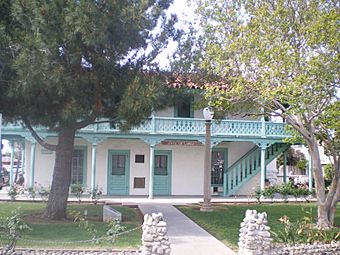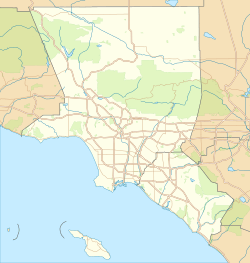Lopez Adobe facts for kids
Quick facts for kids |
|
|
Lopez Adobe
|
|

Lopez Adobe, 2008
|
|
| Location | 1100 Pico St., San Fernando, California |
|---|---|
| Built | 1882 |
| Architect | Lopez, Valentino |
| Architectural style | Monterey |
| NRHP reference No. | 71000157 |
| Added to NRHP | May 6, 1971 |
The López Adobe is a very old house located at 1100 Pico Street in San Fernando, California. It is one of the two oldest private homes in the San Fernando Valley. This historic house was built in 1882 by early settlers of the San Fernando Valley. It stands close to the San Fernando Mission. In 1971, the López Adobe was added to the National Register of Historic Places. This means it is a special place recognized for its history.
The house had a big reopening on March 22, 2015. Now, you can visit it for public tours. These tours happen on the fourth Sunday of every month. They are open from 12 PM to 4 PM.
Contents
Meet Gerónimo and Catalina López
Gerónimo López was born in Los Ángeles in 1828. He was an army messenger in 1847 during the Mexican–American War. He delivered important papers, called the Articles of Capitulation, to General John C. Fremont. These papers helped end the war in southern Alta California.
Catalina López was the only daughter of Pedro López. Her father was in charge of the San Fernando Rey de España Mission. Catalina grew up at the mission. She moved to Los Ángeles in 1847. Later, she returned to the San Fernando Valley to marry Gerónimo López.
The First López Station
In 1861, Gerónimo and Catalina López bought about 40 acres (160,000 m²) of land. This land was near the San Fernando Mission. They built an adobe house there. This house was along the Butterfield Overland Mail route. This was a wagon road that connected Los Angeles and San Francisco. Their first adobe home became known as López Station.
The López couple also ran the first general store in the San Fernando Valley. They started the first English language school there too. In 1869, they opened the first post office at this location.
People who lived in the San Fernando Valley long ago remembered the López family. They said that in the late 1860s and early 1870s, the valley was mostly wild. There were high mustard fields and cattle. The mission and a few adobe homes were the only signs of people. The López family's stage house was a key spot. They were very important in the valley's early growth. They helped set up the first post office and the first English-speaking school.
The original López Station adobe was torn down in the 1910s. This happened to make way for the San Fernando Reservoir. This reservoir is now called Van Norman Reservoir. It was part of the new Los Angeles Aqueduct system. After the 1971 San Fernando earthquake, the old foundation was seen again. It was later covered when the Los Angeles Police Department built a training center.
In 1874, Senator Charles Maclay and his partners bought the northern part of the Rancho Ex-Mission San Fernando. The López family's land was in the part Maclay owned. Maclay then planned the new town of San Fernando. This new town was next to the railroad, which arrived in the valley that same year.
The Current López Adobe
Building the Adobe in the 1800s
Between 1882 and 1883, the López family built a bigger adobe house. They used large, sun-baked blocks for the walls. This house, which still stands today, was built by Valentin López. He was Gerónimo's cousin and brother-in-law. It was the first two-story adobe house built as a home in the San Fernando Valley. Today, it is considered the oldest building still standing in the City of San Fernando.
The house is special because it mixes two building styles. It has parts of Mission Revival architecture and Victorian architectural style. Catalina López designed the Victorian parts of the house. The first local newspaper, the San Fernando Times, was printed here in April 1889.
Changes in the 1900s
Catalina López passed away in 1918. Gerónimo López died in 1921 when he was 90 years old. In 1928, one of their daughters, Louisa López McAlonan, made some changes to the house. The staircase to the balcony was changed. Some rooms were divided to create apartments. Modern plumbing and electricity were also added. The original roof, made of wood shingles, was replaced with clay tiles.
Members of the López family continued to live in the adobe until 1961. The last López family member to live there was another daughter, Kate López Millen. She lived in an upstairs apartment from 1931 until just before she passed away in 1961. The property stayed in the López family until 1971.
The City of San Fernando Buys the Adobe
In 1970, the City of San Fernando announced it wanted to buy the property. It took over a year to get the $70,000 needed to buy it. Plans to get money from the HUD didn't work out at first. In early 1971, the owners set a deadline for the purchase. They said the building would be torn down if it wasn't bought.
When the adobe was listed on the National Register of Historic Places in May 1971, HUD finally agreed to help. They provided a $40,000 grant for historical preservation. The city completed the purchase in late 1971.
Opening as a Museum
The López Adobe was repaired and made new between 1974 and 1975. It opened as a historical site in 1975. The San Fernando Historical Site and Preservation Commission helps run the adobe. It was hard for the city to get enough money to fully fix up the property. They also struggled to keep it open as a full-time museum. Volunteers helped run the adobe. At first, it was open three days a week. Later, this was reduced to just one Sunday a month.
In 1982, more than 100 people who were descendants of the López family gathered at the adobe. They celebrated its 100th anniversary. Gerónimo and Catalina López had thirteen children. Nine of them lived to be adults.
Why the López Adobe is Important
The City of San Fernando is the oldest town in the San Fernando Valley. However, the López Adobe is one of the few buildings left from its early days. Experts have noted its unique style. It is a two-story house with a balcony. It has beautiful wooden railings and a special jigsaw pattern. These parts are painted a pretty turquoise blue. The house is decorated to look like it did between 1883 and 1910.
In 2002, the J. Paul Getty Trust gave a grant to the adobe. They said the López Adobe is an important example of California architecture. It shows how buildings changed after the missions declined. It is also one of the few historic buildings that survived the 1971 and 1994 earthquakes.
The López Adobe has been recognized as a very important historical site.
- In 1945, it was named a State Historic Landmark.
- In 1968, it was registered with the State of California Office of Historic Preservation.
- In 1971, it was listed on the National Register of Historical Places.
Repairs After the Northridge Earthquake
The adobe was damaged during the 1994 Northridge earthquake. It was closed for three years while repairs were made. There were delays in getting money for the repairs. Officials from the Federal Emergency Management Agency (FEMA) disagreed with the city's cost estimate. In April 1996, FEMA and city officials finally agreed on funding. The city paid for the rest of the costs.
Recent Years at the Adobe
The adobe reopened in December 1997. There was a ceremony with songs, Mexican dances, and the lighting of the town Christmas tree.
In 2003, Congressman Howard Berman helped get $150,000 in federal money. This money was for the historic preservation of the López Adobe. He said it was a "national treasure" that deserved federal help.
As of 2004, there wasn't enough money to keep the adobe open more often. It was open only one day per month. Despite years of trying to raise money, they had only collected half of what was needed. This lack of funding meant the property was closed for tours from 2007 to 2015.
The adobe had a big reopening on March 22, 2015. Since then, it has been open for public tours. These tours are led by guides. They happen on the fourth Sunday of every month from 12 PM to 4 PM.
See also




